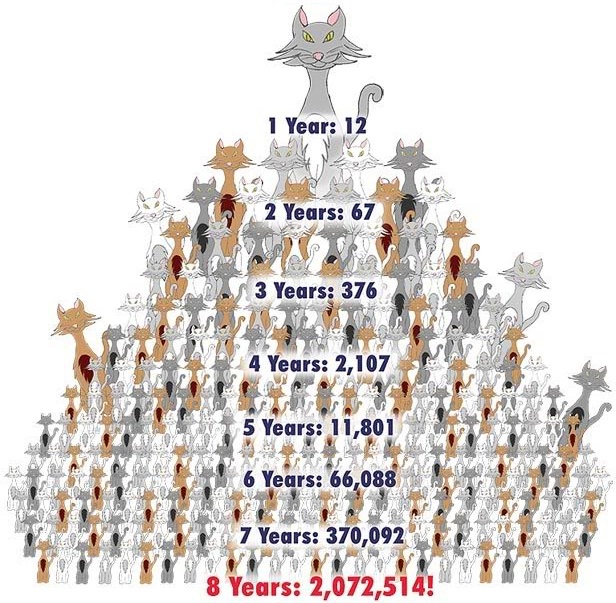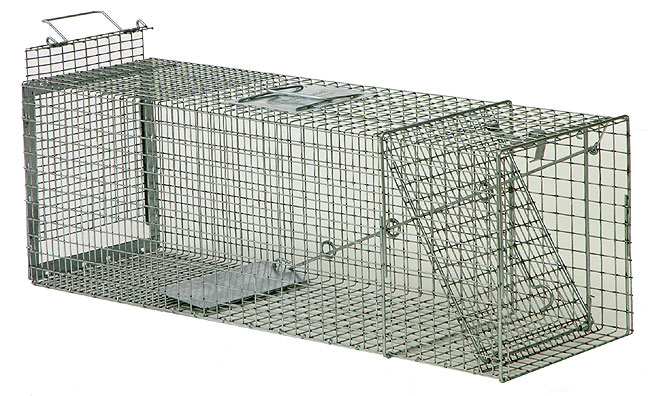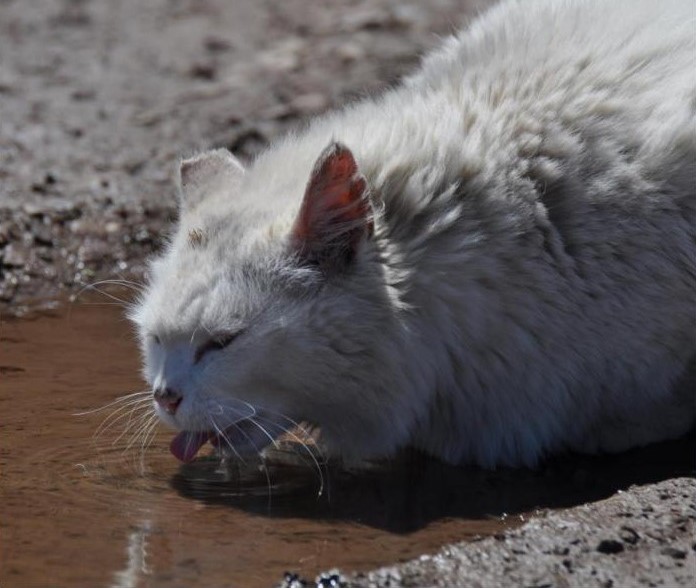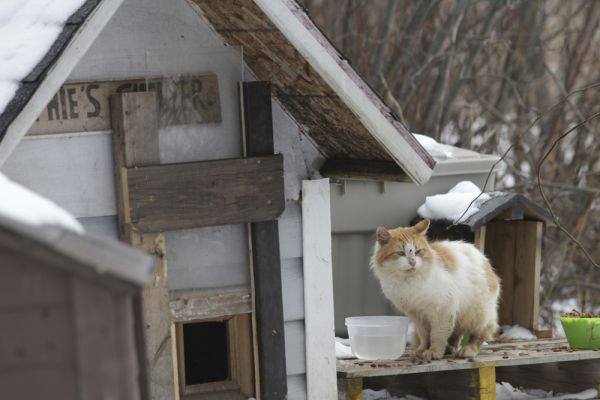Improving quality
of life for
Cape Breton cats
FAACS FAQ's
Why do you RETURN in TNR?
What is the difference between a Feral cat and a stray/abandoned cat?
How Can I Manage a Feral Cat Colony?
- That each year there are far more kittens born than there are homes for.
- That only 1 kitten in every litter of 5 will live out its life loved and cared for.
- That the remaining 80% will die of neglect, abuse, and disease, and in some regions, euthanized as “surplus” kittens.
- That for those fortunate enough to be adopted, only 1 in every 3 cats will live out its life in that same home.
- That the reproductive abilities of cats far exceed those of dogs.
- That in 7 years, it is possible for 2 animals and their offspring to reproduce as follows:
- 1 female dog + 1 male dog = 2,000 puppies
- 1 female cat + 1 male cat = 450,000 kittens (not all survive)
- That prevention through neutering and spaying is the most humane and cost effective means of reducing cat overpopulation and the consequent misery of more “unwanted” kittens being born.
- That you can make a difference in lowering the number of unwanted kittens, born only to die, by spaying or neutering your cats.
This chart represents an unspayed female cat, her mate and all of their offspring, producing 2 litters per year, with 2.8 surviving kittens per litter:

What is TNR?
Trap-Neuter-Return, or TNR, involves trapping, fixing, and ear-tipping the feral and stray cats in a colony, then returning them to their territory. This practice humanely limits breeding and population growth, and ear-tipping lets us know which cats have already been spayed or neutered. See the section below, How Can I Manage a Feral Colony, for the full process of TNR and caring for homeless cats.

This is a humane trap used for TNR.

Photographed in Edwardsville, this feral cat has been painlessly ear-tipped under anesthetic to indicate it has been neutered. Photo by Deana Lloy
Why do you RETURN in TNR?
After feral cats have recuperated from surgery, they are released back to where they were trapped from. We return these cats because the outdoors is their home, and most feral cats are not suitable as house pets. Feral cats can be helpful with neighborhood pest control, but, when possible, we work with others to find homes for friendly cats and tamable kittens.
What is the difference between a Feral cat and a stray/abandoned cat?
Feral: A feral cat is an unsocialized outdoor cat who has never had any physical contact with humans. Or their human contact has diminished over time—enough that the cat is no longer accustomed to people.
Abandoned or Stray: Stray or abandoned cats are socialized to humans – in most cases they were once pets who have either become lost or were, unfortunately, abandoned. Stray cats may become feral as their contact with humans dwindles or, in a happier scenario, become loving pets again if they are taken in.
How Can I Manage a Feral Cat Colony?
Basic steps
So, you’ve decided you want to help the colony of feral cats in your neighborhood. What do you do? The process of Trap-Neuter-Return (TNR) offers the greatest chance of success for you and the cats. TNR involves trapping the cats in a colony, getting them spayed or neutered, tested for feline illnesses (if the tests are affordable), and surgically ear-tipped for identification as being fixed, then returning the ferals to their territory.
As a caretaker, you must provide regular food and shelter and monitor for any newcomers or other problems in the colony.
If you want to undertake a TNR project in your neighborhood and care for a managed colony, here’s an outline of the basic steps to be taken:
1. Educate Yourself
First, start by learning all you can about TNR. There are a variety of materials available on the internet, and the local FAACS trapping volunteers have years of experience that they can share.
If you live in the CBRM area, we recommend you contact us about attending one of our members’ meetings so you can meet our trappers. They can arrange to take you on a ride along and show you how to set the traps, transport the cats, keep them in holding before their trip to the veterinarian, and provide instructions for post-care and return of the feral cats to their colony.
2. Build Good Community Relations
In tackling your feral cat colony, it is of paramount importance that you build good community relations. Unless the cats live in a remote setting, you must consider their human neighbors and try to build positive, harmonious relations. A supportive, cooperative community will make your work considerably easier.
3. Set Up Feeding Stations and Shelters
There are many benefits to managing the colony as soon as possible. Start by setting up a feeding station. By arranging a regular feeding schedule, you will train the cats to show up at a particular place at a certain time, and you’ll be able to withhold food and get them hungry when you want to start trapping. (Humane traps have food inside.) Enhancing the cats’ nutrition by improving the quality of their food will also better prepare colony cats for the stress of trapping and neutering. And providing safe and adequate shelter also promotes their health and assists in locating them.

Photographed in North Sydney in November 2012, this feral cat has been provided with food, water and shelter.
4. Secure an adequate holding space for trapping and neutering
Depending on the colony’s size, trapping all of the cats may take several days to several weeks, as some cats can be elusive. A space is needed to hold the cats trapped until they can be transported to the veterinarian. Space is also required for them to recover for 24-48 hours following surgery.
While they recover, they are confined in their traps to restrict movement. The traps may be cleaned during this time if soiled (depending on the cats’ temperament), and you should feed the cats twice a day. To learn how to do this safely, one helpful reference is: “Caring for Cats Held in Traps” on www.neighborhoodcats.org.
It’s best to keep the cats in a secure holding space, protected from the elements and heated in cold weather. It could be a basement, a garage, an extra room, or a terrace using a tarpaulin, tent, or lean-to. One word of warning: fleas can be a concern in indoor holding spaces during warmer seasons. To minimize the risk of infestation, keep the traps covered with light sheets and either flea bomb or vacuum thoroughly afterward.
5. Decide what to do with kittens and friendly adults
It is important to decide what to do with kittens and friendly adults before you start trapping, and when you still have time to prepare. Ideally, adoptable cats and kittens will be removed from the colony and placed in good homes. Decide before you catch them who is going to do the fostering and how you’ll go about adopting them. You can, for example, work with a traditional rescue group. If fostering or adopting resources are simply not available, don’t let that stop you from getting the cats neutered and halting the reproduction cycle. You’ll have accomplished a great deal of good by that alone.
6. Arrange for spay/neuter
FAACS can assist you with making an appointment with a local veterinarian clinic where discounted rates have been negotiated for our organization. Only appointments made through FAACS will be paid for by FAACS and receive our discount.
7. Trapping
Trapping is the last step. Too often, well-meaning people trap first and think about what to do with the cats later. That’s a recipe for disaster (we know, we’ve tried it!) To ensure the long-term success of your project, and to minimize the problems you will need to deal with, you should ensure that everything else is in place before you put the tuna into the first trap. This is true whether you’re trapping one cat at a time, or the entire colony.
Enjoy!
A few days after being released, the cats will return to their usual routines and you to yours. Although caring for feral cats is an ongoing effort, and the dangers they face are ever present, there is a strong sense of satisfaction in knowing you’ve prevented a great deal of suffering and have given the cats a better chance to live in a way that suits them and is acceptable to your community.
